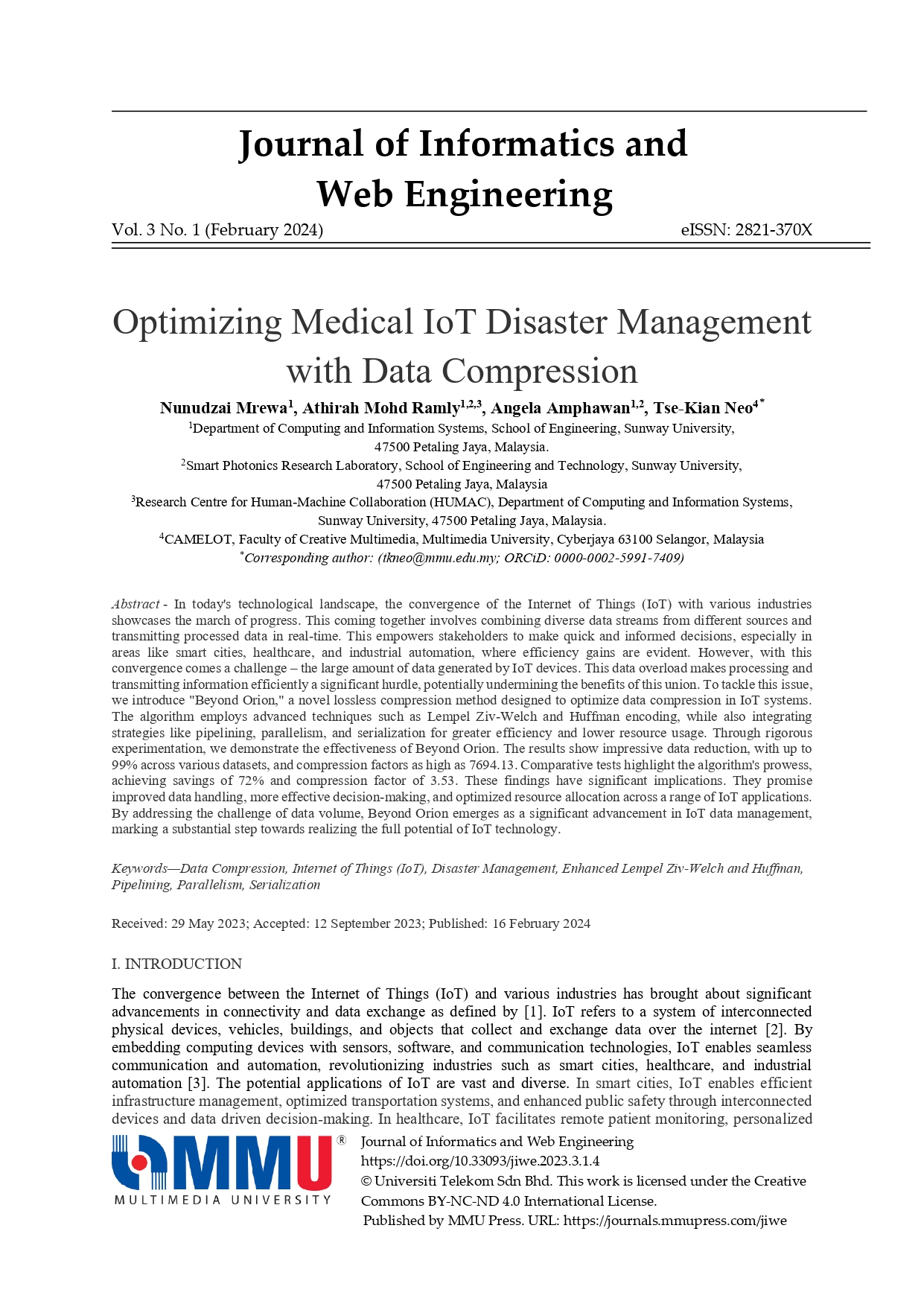Optimizing Medical IoT Disaster Management with Data Compression
Main Article Content
Abstract
In today's technological landscape, the convergence of the Internet of Things (IoT) with various industries showcases the march of progress. This coming together involves combining diverse data streams from different sources and transmitting processed data in real-time. This empowers stakeholders to make quick and informed decisions, especially in areas like smart cities, healthcare, and industrial automation, where efficiency gains are evident. However, with this convergence comes a challenge – the large amount of data generated by IoT devices. This data overload makes processing and transmitting information efficiently a significant hurdle, potentially undermining the benefits of this union. To tackle this issue, we introduce "Beyond Orion," a novel lossless compression method designed to optimize data compression in IoT systems. The algorithm employs advanced techniques such as Lempel Ziv-Welch and Huffman encoding, while also integrating strategies like pipelining, parallelism, and serialization for greater efficiency and lower resource usage. Through rigorous experimentation, we demonstrate the effectiveness of Beyond Orion. The results show impressive data reduction, with up to 99% across various datasets, and compression factors as high as 7694.13. Comparative tests highlight the algorithm's prowess, achieving savings of 72% and compression factor of 3.53. These findings have significant implications. They promise improved data handling, more effective decision-making, and optimized resource allocation across a range of IoT applications. By addressing the challenge of data volume, Beyond Orion emerges as a significant advancement in IoT data management, marking a substantial step towards realizing the full potential of IoT technology.
Article Details

This work is licensed under a Creative Commons Attribution-NonCommercial-NoDerivatives 4.0 International License.
All articles published in JIWE are licensed under a Creative Commons Attribution-NonCommercial-NoDerivatives 4.0 International (CC BY-NC-ND 4.0) License. Readers are allowed to
- Share — copy and redistribute the material in any medium or format under the following conditions:
- Attribution — You must give appropriate credit, provide a link to the license, and indicate if changes were made. You may do so in any reasonable manner, but not in any way that suggests the licensor endorses you or your use;
- NonCommercial — You may not use the material for commercial purposes;
- NoDerivatives — If you remix, transform, or build upon the material, you may not distribute the modified material.
References
N. Jain, A. Chaudhary, N. Sindhwani, and A. Rana, “Applications of wearable devices in iot,” in 2021 9th International Conference on Reliability, Infocom Technologies and Optimization (Trends and Future Directions) (ICRITO), pp. 1–4, 2021.
Z. Adiguzel, “Examining strategic fit and innovation in terms of competitive strategies and knowledge management,” in Handbook of Research on Strategic Fit and Design in Business Ecosystems, pp. 25–52, IGI Global, 2020.
K. Shafique, B. A. Khawaja, F. Sabir, S. Qazi, and M. Mustaqim, “Internet of things (iot) for next-generation smart systems: A review of current challenges, future trends and prospects for emerging 5g-iot scenarios,” IEEE Access, vol. 8, pp. 23022–23040, 2020.
A. Rawat and A. Pandey, “Recent trends in iot : A review,” Journal of Management and Service Science (JMSS), vol. 2, p. 1–12, Nov. 2022.
I. Yaqoob, E. Ahmed, I. A. T. Hashem, A. I. A. Ahmed, A. Gani, M. Imran, and M. Guizani, “Internet of things architecture: Recent advances, taxonomy, requirements, and open challenges,” IEEE wireless communications, vol. 24, no. 3, pp. 10–16, 2017.
S. Yousefi, H. Karimipour, and F. Derakhshan, “Data aggregation mechanisms on the internet of things: A systematic literature review,” Internet of Things, vol. 15, p. 100427, 2021.
The Editors of Encyclopedia Britannica, Morse Code. Jan. 2023.
F. Marcelloni and M. Vecchio, “A simple algorithm for data compression in wireless sensor networks,” IEEE Communications Letters, vol. 12, no. 6, pp. 411–413, 2008.
H. M. Al-Kadhim and H. S. Al-Raweshidy, “Energy efficient data compression in cloud based iot,” IEEE Sensors Journal, vol. 21, no. 10, pp. 12212– 12219, 2021.
W. Kinsner and R. Greenfield, “The lempel-ziv-welch (lzw) data compression algorithm for packet radio,” in [Proceedings] WESCANEX ’91, pp. 225–229, 1991.
T. Sheltami, M. Musaddiq, and E. Shakshuki, “Data compression techniques in wireless sensor networks,” Future Gener. Comput. Syst., vol. 64, p. 151–162, nov 2016.
B. R. Stojkoska and Z. Nikolovski, “Data compression for energy efficient iot solutions,” in 2017 25th Telecommunication Forum (TELFOR), pp. 1–4, 2017.
T. Dang, N. Bulusu, and W.-c. Feng, “Rida: A robust information-driven data compression architecture for irregular wireless sensor networks,” in Wireless Sensor Networks (K. Langendoen and T. Voigt, eds.), (Berlin, Heidelberg), pp. 133–149, Springer Berlin Heidelberg, 2007.
A. Ukil, S. Bandyopadhyay, and A. Pal, “Iot data compression: Sensoragnostic approach,” in 2015 Data Compression Conference, pp. 303–312, 2015.
M. R. Chowdhury, S. Tripathi, and S. De, “Adaptive multivariate data compression in smart metering internet of things,” IEEE Transactions on Industrial Informatics, vol. 17, no. 2, pp. 1287–1297, 2021.
U. Jayasankar, V. Thirumal, and D. Ponnurangam, “A survey on data compression techniques: From the perspective of data quality, coding schemes, data type and applications,” Journal of King Saud University – Computer and Information Sciences, vol. 33, no. 2, pp. 119–140, 2021.
I. M. Pu, “Chapter 1 - introduction,” in Fundamental Data Compression (I. M. Pu, ed.), pp. 1–17, Oxford: Butterworth-Heinemann, 2006.
A. Hanumanthaiah, A. Gopinath, C. Arun, B. Hariharan, and R. Murugan, “Comparison of lossless data compression techniques in low-cost low-power (lclp) iot systems,” in 2019 9th International Symposium on Embedded Computing and System Design (ISED), pp. 1–5, 2019.
A. Vallimayil, K. M. K. Raghunath, V. R. S. Dhulipala, and R. M. Chandrasekaran, “Role of relay node in wireless sensor network: A survey,” in 2011 3rd International Conference on Electronics Computer Technology, vol. 5, pp. 160–167, 2011.
J. B. Ernst, “Chapter 14 - energy-efficient next-generation wireless communications,” in Handbook of Green Information and Communication Systems (M. S. Obaidat, A. Anpalagan, and I. Woungang, eds.), pp. 371–392, Academic Press, 2013.
H. A. AL-Khafaji, H. M. AlSabbagh, A. Al-Omary, and H. Al-Rizzo, “Influence of relays location and propagation environment on the ber of multiple relay systems,” KnE Engineering, vol. 3, p. 314–324, Oct. 2018.

